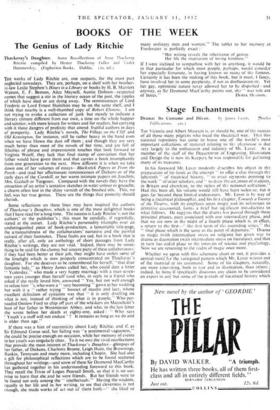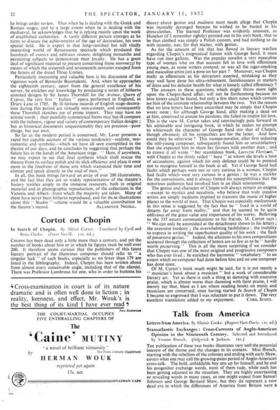Stage Enchantments
Drama: Its Costume and Decor. By James Laver. (Studio
Publications. 3os.)
THE Victoria and Albert Museum is, or should be, one of the meccas of all those many pilgrims who tread the theatrical way. That this national repository has come to house one of the world's most important collections of material relating to the playhouse is due very largely to the enthusiasm and industry of Mi. Laver. As a member of the staff of the Department of Engraving. Illustration and Design (he is now its Keeper), he was responsible for gathering many of its treasures.
In his foreword Mr. Laver modestly describes his object in the preparation of his book as the attempt " to offer a clue through the labyrinth " of theatrical history, " to erect sigeposts pointing to the work " of other scholars, and" to draw the attention of students, in Britain and elsewhere, to the riches of the national collection." Had this been all, his volume would still have been welcome, but it goes far beyond these limited endeavours. Mr. Laver is by way of being a theatrical philosopher, and his firet chapter, Towards a Theory of the Theatre, with its emphasis upon magic and its references to primitive ceremonial, forme a brief but sigaificant introduction to what follows. He suggests that the drama has passed through three principal phases, men associated with one intermediary phase, and that we are now in the midst of a fourth phase which is, in effect, a return to the first—" the first term of the ascending series," the final phase which is the same as the point of departure." Drama as magic (with intermediate stress on religion) has given way to drama as decoration (with intermediate stress on literature), and that in turn has ceded place to the interests of science and psychology. Now we are returning to the realm of magic once more.
Whether we agree with this schematic chart or not, it provides a central motif for the variegated pattern which Mr. Laver weaves out of the material at his command. Some of his chapters, naturally, are more interesting, both in text and in illustration, than others ; indeed, he hims, lf specifically disavows any claim to be considered an expert in any but some of the periods of theatrical history which he brings under review. Thus when he is dealing with the Greek and Roman stages, and to a large extent when he is dealing with the mediaeval, he acknowledges that he is relying mainly upon the work of established authorities. A vastly different picture emerges as he turns to discuss the achievements of the age of decoration, his own special field. He is expert in that long-vanished but still vitally interesting world of Renaissance spectacle which produced the hundreds of entrées and tableaux vivants, delighting monarchs and permitting subjects to demonstrate their loyalty. He has a great deal of significant material to present concerning those intermezzi by means of which the sixteenth and seventeenth centuries escaped from the fetters of the dread Three Unities.
Particularly interesting and valuable here is his discussion of the vigorous work of Bernardo Buontalenti. And, when he approaches the eighteenth century, apart from the general excellence of his survey, he enriches our knowledge by producing a series of hitherto unnoted designs by Sir James Thornhill for the Arsinoe, Queen of Cyprus, the very first " Italian" opera performed in England, at Drury Lane in 1705. By ill fortune records of English stage-decora- tion during this period are virtually non-existent, and consequently these Thornhill sketches are of prime import. They may have no artistic worth ; their painfully symmetrical forms may but ill compare with the richness, vigour and variety of contemporary Italian designs ; but as historical documents unquestionably they are precious—poor things, but our own.
So far as the modern period is concerned, Mr. Laver presents a rapid but capable account of the various tendencies—realistic, nec- romantic and symbolic—which we have all seen exemplified in the theatre of our days, and he concludes by suggesting that perhaps the future lies in the hands of the American stage. " Here, if anywhere, we may expect to see that final synthesis which shall rescue the theatre from its surface polish and its slick efficiency and place it once more in the forefront of those arts which transcend their time and climate and speak directly to the soul of man."
In all, this book brings forward an array of over 200 illustrations, and the fact that they are so widely representative of the theatre's history testifies amply to the immense resources, both in original material and in photographic reproduction, of the collections in the Victoria and Albert—from which the majority are taken. Many of them have never been hitherto reproduced, and for these illustrations alone this " Studio " volume would be a valuable contribution to



































 Previous page
Previous page